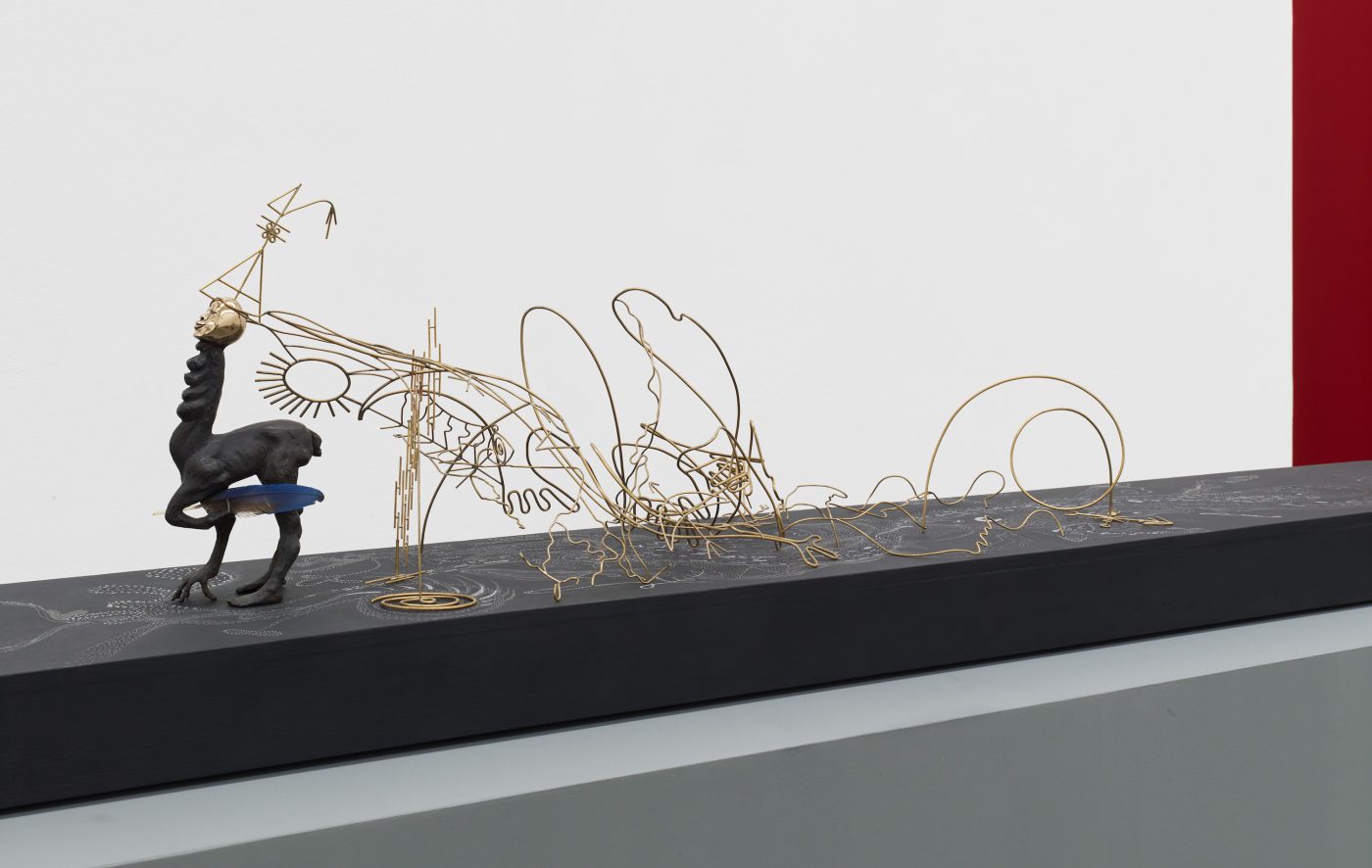
Jasmine Thomas-Girvan, Rooted, 2016, Bronze, plywood and macaw feather (Ara ararauna). Exhibition overview Jasmine Thomas-Girvan, Bathed in Sacred Fire, 2021, Art Institute Melly, Rotterdam NL. Photographer: Kristien Daem
Colonial trauma up close and at length: Jasmine Thomas-Girvan at Kunstinstituut Melly
While Jasmine Thomas-Girvan engages with specific historical events, folklore, myths and literary works from the Caribbean region, her oeuvre expresses notions of resistance, hope and repair.
Bathed in Sacred Fire at Kunstinstituut Melly is Jasmine Thomas-Girvan’s first show in Europe. It initiates a discussion about Caribbean identity and how it is shaped, scarred, but also transcends the archipelago’s violent colonial history. The exhibition presents recent sculptures and newly-commissioned works by the Jamaican artist based in Trinidad and Tobago, that have been aptly described as ‘poetic assemblages’ of materials and motifs. Through Bathed in Sacred Fire, I was introduced to the diverse cosmologies, layered colonial history and rich heritage of the Caribbean for the first time. First colonised by Spain in the 15th century, the English the Dutch and the French also lay claim to the islands over subsequent centuries. Over the course of the slave trade, African and Indian slave workers were transported to the Caribbean by the colonising powers. These populations, combined with the Indigenous communities, led to the growth of multiracial societies and hybrid cultures.
While Thomas-Girvan engages with specific historical events, folklore, myths and literary works from the region, her oeuvre expresses notions of resistance, hope and repair also explored by other contemporary artists working with colonial pasts and decolonial futures. There is a lot to be taken in, and not just due to the quantity of works being shown and stories being shared. Each work beckons to be looked at closely and at length. The artist’s background in jewellery-making is traceable in the painstaking attention to detail present in every object, along with the use of materials, including stone, wood, bones, feathers, metal wire, silverware, seed and architectural detritus, that can be easily held and worked by hand: bent, cut, painted, stitched, and neatly arranged. Intricate patterns and visual metaphors such as tea-blood spilling from a cup gradually reveal themselves as you walk towards the piece, while aesthetic clues from different cultures are mixed together, generating new meanings.
[blockquote]The artist’s background in jewellery-making is traceable in the painstaking attention to detail present in every object
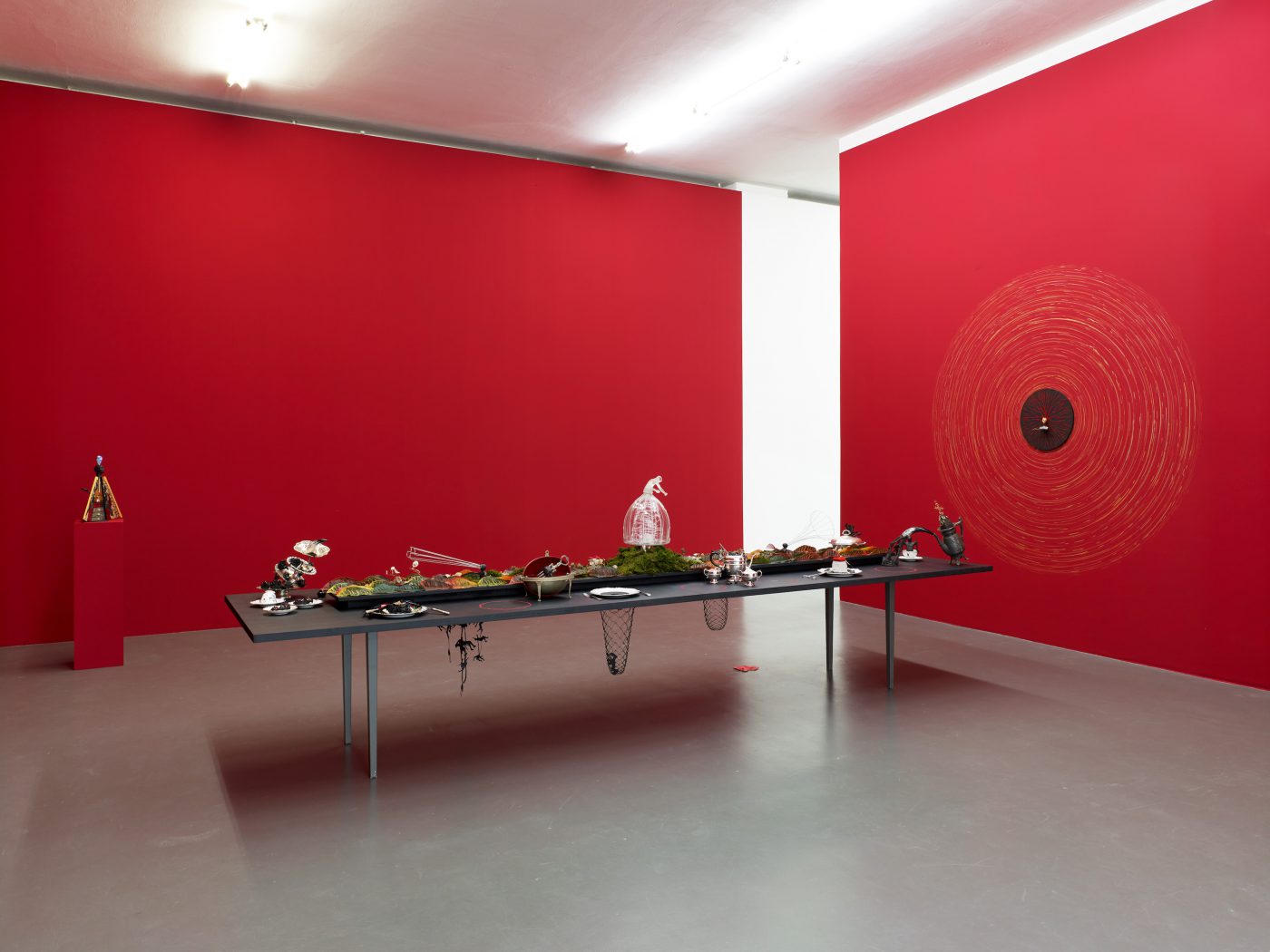
Jasmine Thomas-Girvan, Proof of Spirit, 2017, Bronze, wood, sterling silver, Rubies, Citrine, fishbone, calabash; Ancestral Anguish, 2017, Bronze, wood, paper; Dreaming Backwards, 2016–2019, Porcelain, silverware, bronze, paper, Holstein cow horn, machete, plexi, silk, coconut shell (Cocos nucifera). Exhibition overview Jasmine Thomas-Girvan, Bathed in Sacred Fire, 2021, Art Institute Melly, Rotterdam NL. Photographer: Kristien Daem
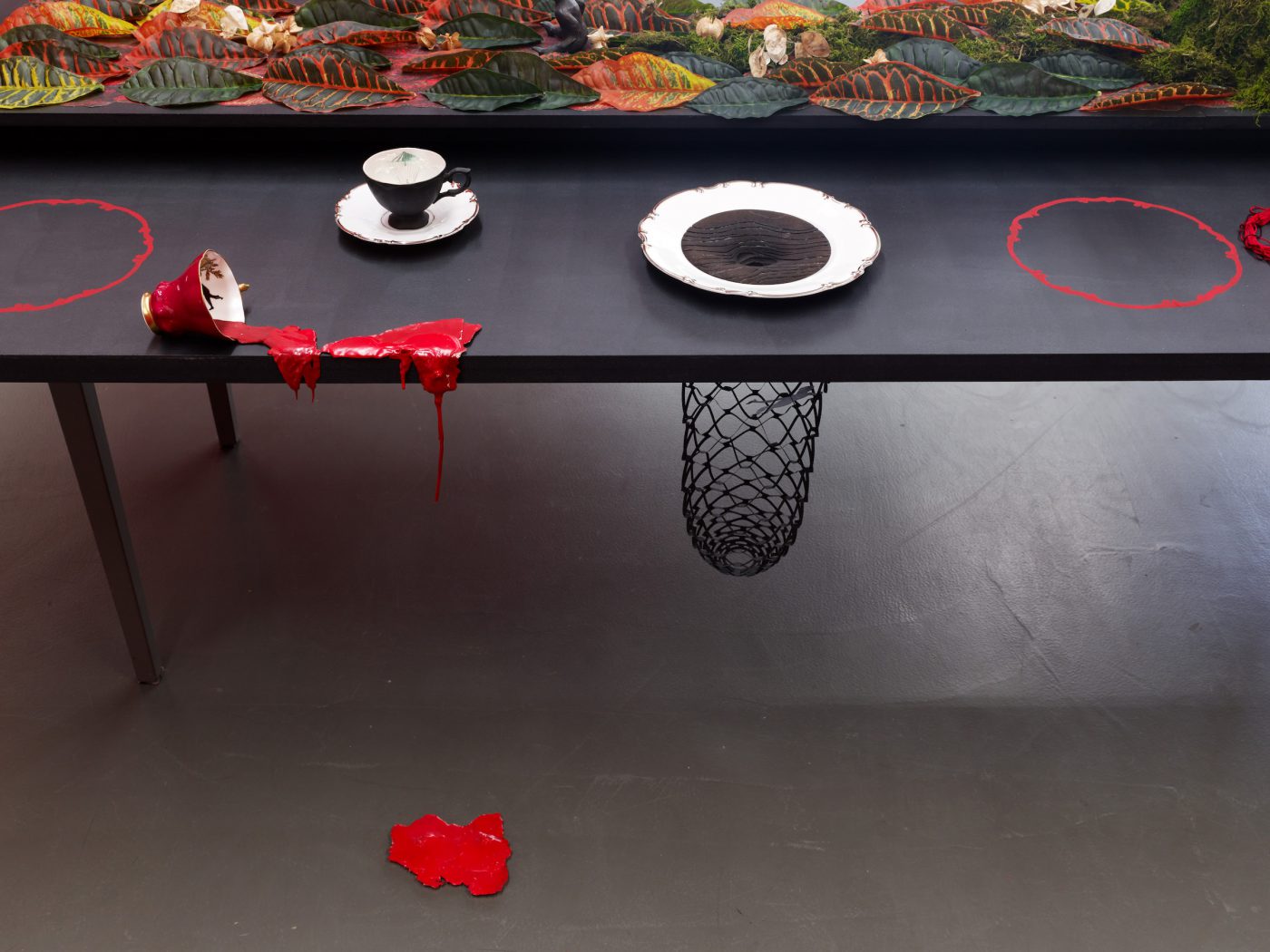
Jasmine Thomas-Girvan, Dreaming Backwards, 2016–2019, Porcelain, silverware, bronze, paper, Holstein cow horn, machete, plexi, silk, coconut shell (Cocos nucifera). Exhibition overview Jasmine Thomas-Girvan, Bathed in Sacred Fire, 2021, Art Institute Melly, Rotterdam NL. Photographer: Kristien Daem.
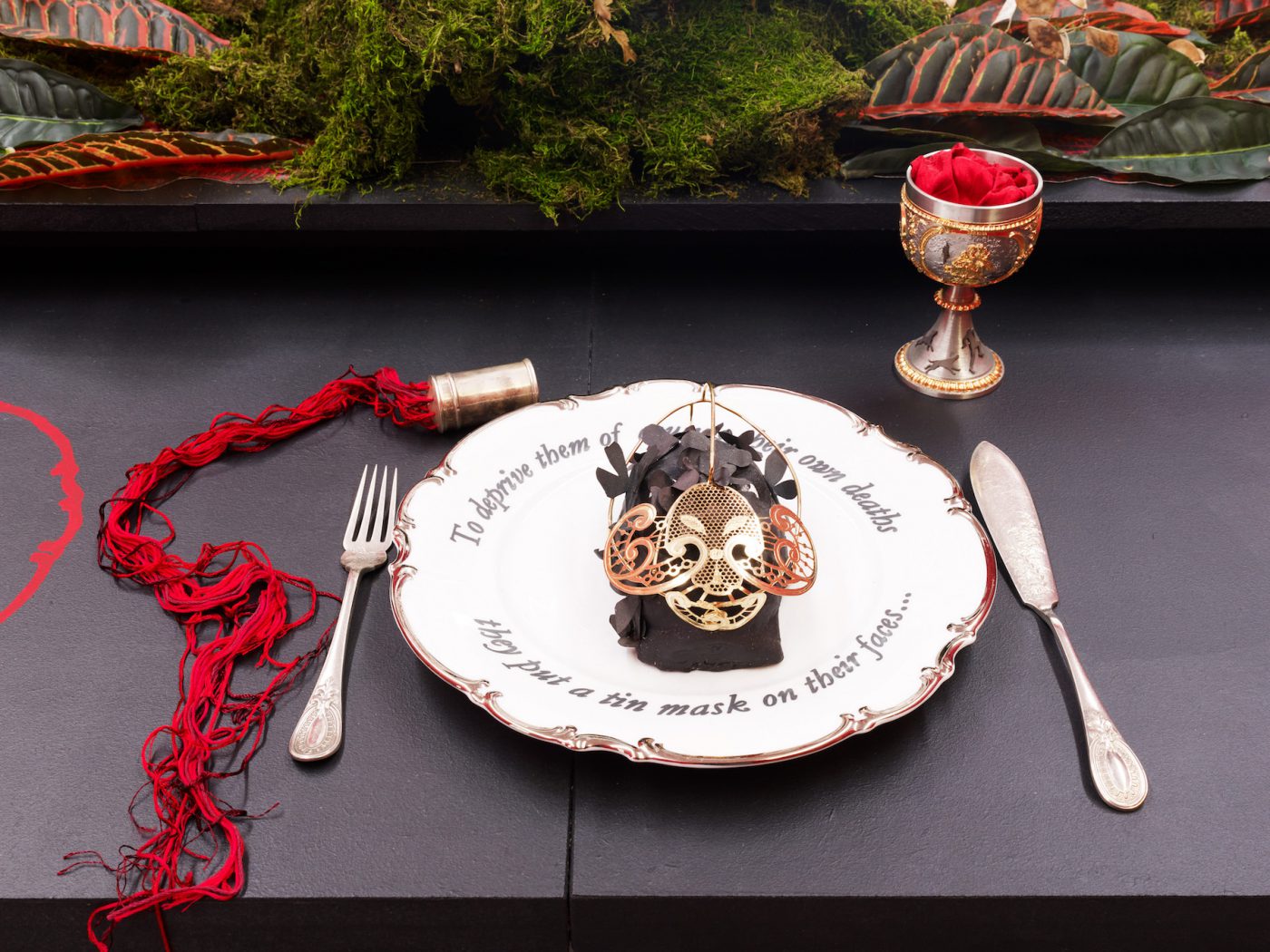
Jasmine Thomas-Girvan, Dreaming Backwards, 2016–2019, Porcelain, silverware, bronze, paper, Holstein cow horn, machete, plexi, silk, coconut shell (Cocos nucifera). Exhibition overview Jasmine Thomas-Girvan, Bathed in Sacred Fire, 2021, Art Institute Melly, Rotterdam NL. Photographer: Kristien Daem.
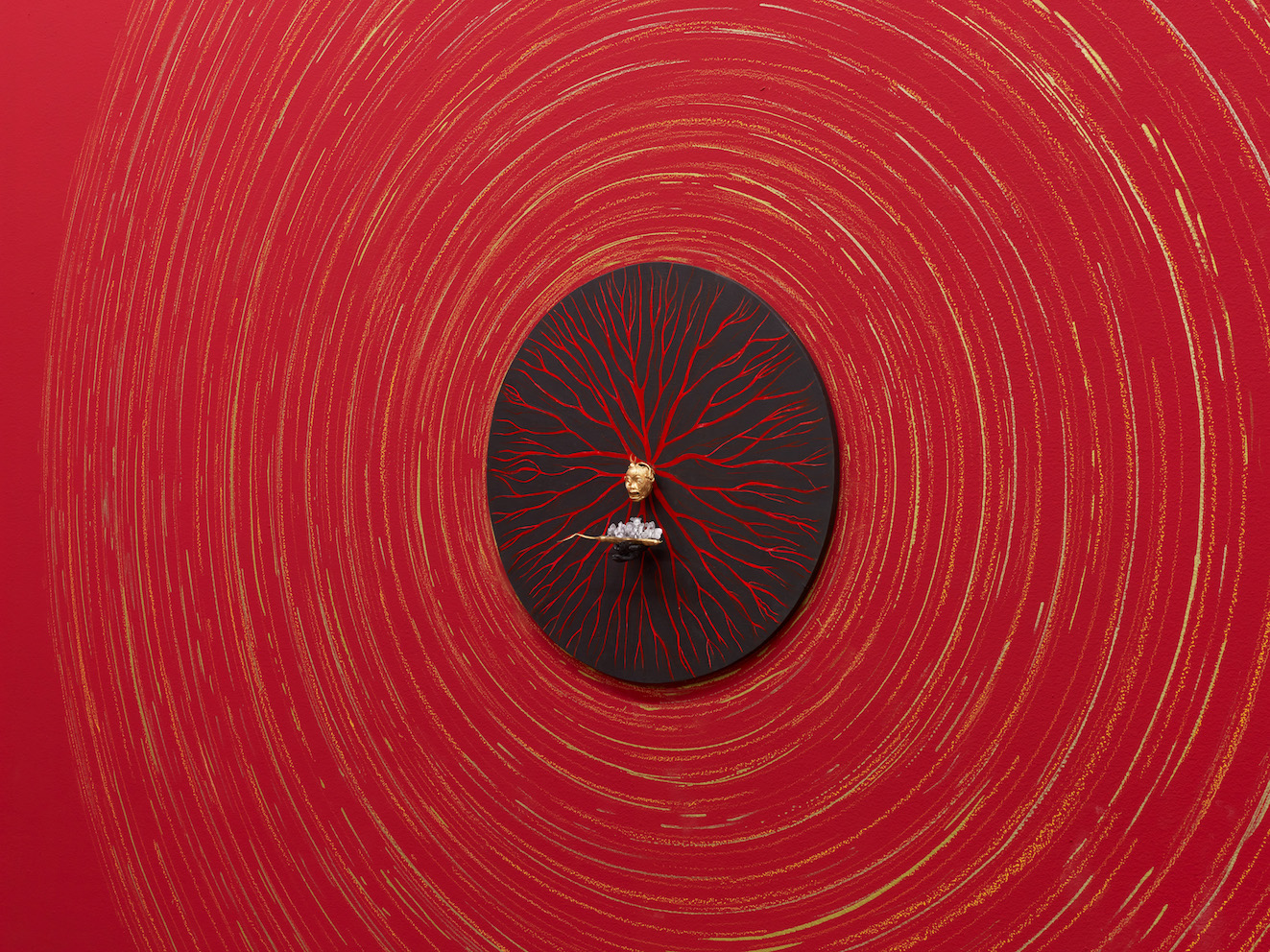
Jasmine Thomas-Girvan, Ancestral Anguish, 2017, Bronze, wood, paper. Exhibition overview Jasmine Thomas-Girvan, Bathed in Sacred Fire, 2021, Art Institute Melly, Rotterdam NL. Photographer: Kristien Daem
Through this necessity to be up close and personal in order to really start unpacking the works, a sense of intimacy and in a way, solidarity, is generated in relation to the residual trauma and violence inflicted on colonised bodies the artist recounts. The exhibition’s ‘centrepiece’ is a large-scale sculptural installation titled Dreaming Backwards (2016-19) that, at first glance and from a distance, looks like a neatly-arranged and inviting high tea setup. As I make my way towards the table and slowly circle around it, I start noticing the hellish nightmare unfolding before me. Intricate silverware and porcelain – those well-known vestiges of English high society – are littered with strange black figures and details specific to Caribbean culture, such as animal horns and feathers. Hands reaching out for help are pouring out of a teapot, and the cupcakes are all black. Surgical scissors are offered in place of cutlery, while human organs and a Black person’s head donning a metal mask are served on a plate, along with the damning writing; “To deprive them of causing their own deaths they put a tin mask on their faces…”. In this work, European modernity is made to reckon with its dark side – coloniality – in a visceral manner through the juxtaposition of great wealth, luxury and leisure with the immense suffering and violence inflicted for its attainment.
Against this setting, I could not help but read the red walls enclosing the room as a reference to colonial violence and bloodshed; an all-too-predictable interpretation from my part perhaps. Nonetheless, installing this piece within the impersonal and supposed neutral space of the white cube would not have done it justice. The red walls worked to extend it spatially, leading to a dramatic, immersive and implicated aesthetic. Colonialism might be over, but its logic is still operative in societal structures today, including the institutions of art and culture; there is no such space as a neutral space. Other works provide an aesthetic interpretation of contested histories, Caribbean mythologies and contemporary psychological residues of colonialism. For instance, the Belisario body of work, named after Jamaican artist Isaac Mendes Belisario, consists of six silhouetted figures recalling the relationship of Black bodies with ancestral veneration, sacred energies and earth-bound ritualistic practices.
I could not help but read the red walls enclosing the room as a reference to colonial violence and bloodshed; installing this work within the impersonal and supposed neutral space of the white cube would not have done it justice
Queenie (2021) depicts a female figure spreading her arms as if she is about to take flight off the wall, with a glass of water delicately balanced on her head and gold wires extending from underneath her feet all the way to the floor, resembling a tree root system. The work references the origin story of the Kumina ritual code, revealed to Imogene Elizabeth Dixon (Queenie), in visions where people speaking in an ‘African’ language taught her words and songs. As opposed to the dismembered and lifeless Black bodies of the ‘Dreaming Backwards’ table, the Black bodies in the Belisario series are very much whole, alive and thriving. The artist’s skilful bending and shaping of bronze wire extends their vibrant aura outwards into the gallery space. The Turntable series, installed in the same room, speaks to the ways in which music eased suffering during and after the colonial era. At first glance, the dynamic sculptures imbued with magical realism, look like slender humanoid figures dancing in the middle of the gallery. Here again Thomas-Girvan recasts discarded silverware in her animated spindly-legged assemblages, employing objects synonymous with colonial plunder to tell a story of survival.
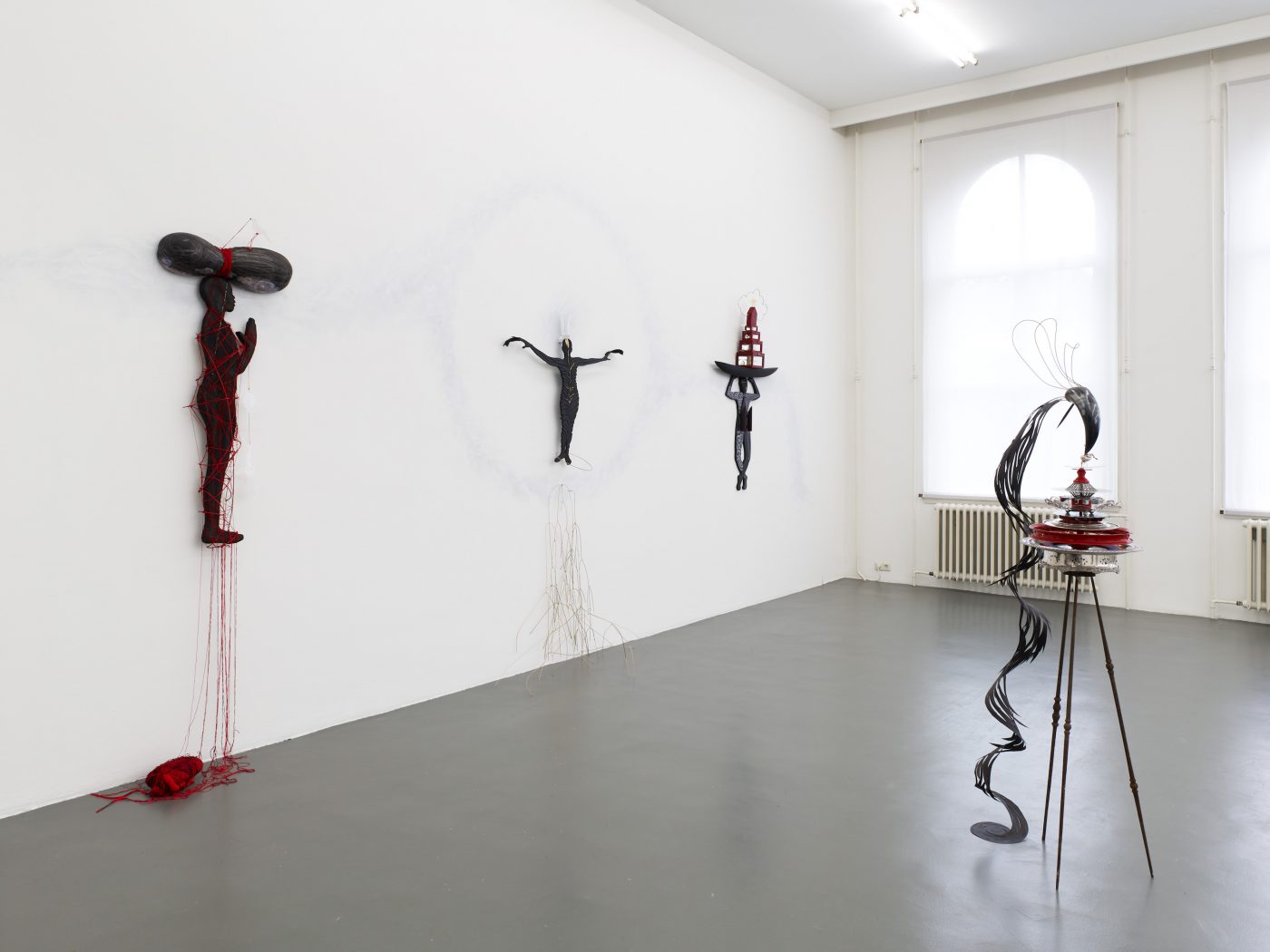
Jasmine Thomas-Girvan, A Cosmic Whispers - HMV (His Master’s Voice), 2018, Macaw feathers (Ara ararauna), Plexi, calabash (Crescentia cujete), recycled silverware, Holstein cow horn, tagua nut (Phytelephas), steel, silver, paper; …for the ones I can’t name… I Love You, 2021, Saman wood, Calabash, Silk cord, Plexi, Bronze wire, gold leaf and fabric; Zangukunu-An instrument for levitation, 2021, wood, bronze, sterling silver, glass; Queenie, 2021, Glass, bronze wire, acetate. Exhibition overview Jasmine Thomas-Girvan, Bathed in Sacred Fire, 2021, Art Institute Melly, Rotterdam NL. Photographer: Kristien Daem.
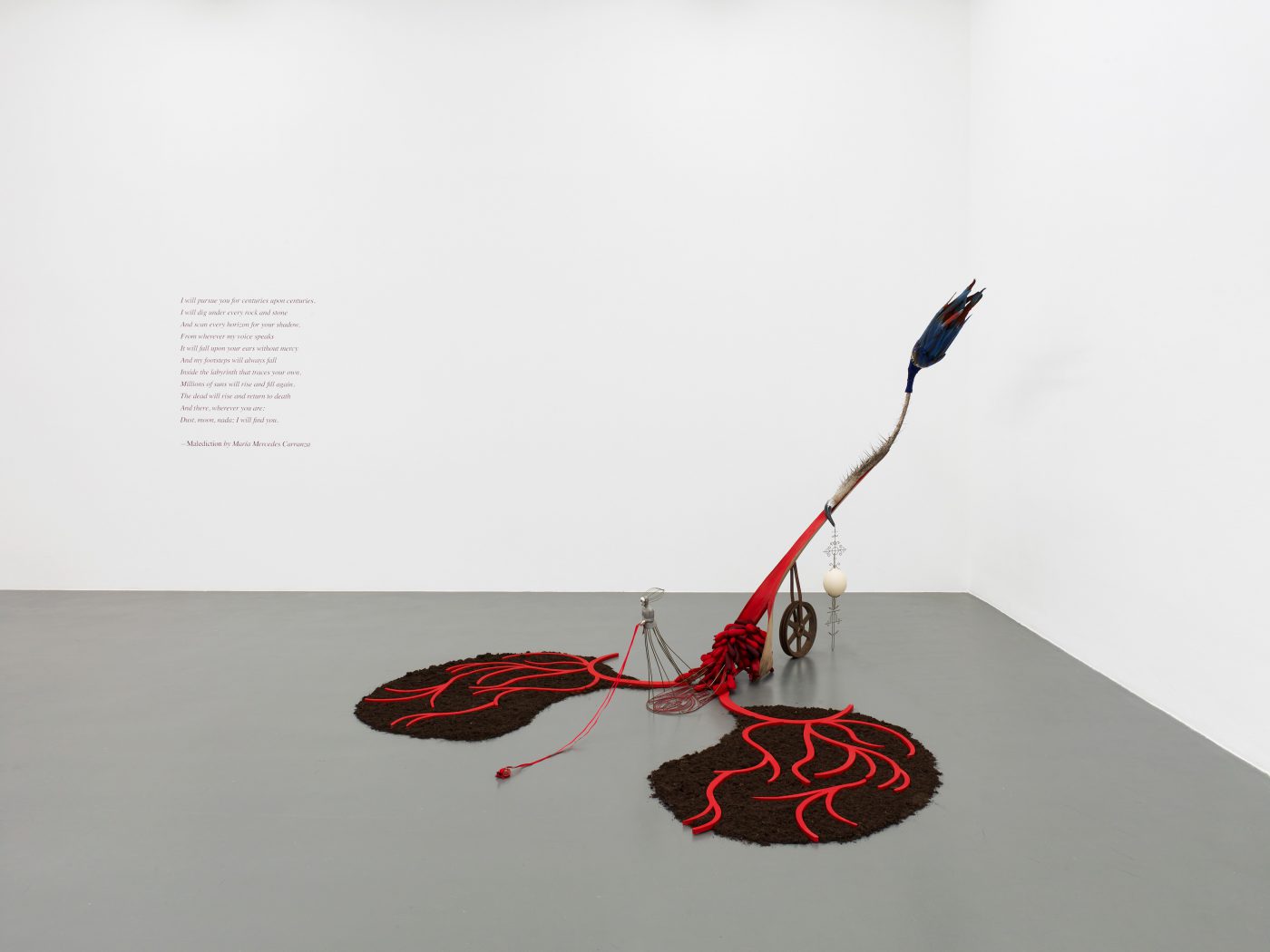
Jasmine Thomas-Girvan, Terra Preta, 2016, Queen Palm Frond (Syagrus romanzoffiana), Macaw feathers (Ara ararauna), recycled cast iron, bicycle wheel, silk, plywood, Ostrich egg (Struthio camelus), bronze and ribbon. Exhibition overview Jasmine Thomas-Girvan, Bathed in Sacred Fire, 2021, Art Institute Melly, Rotterdam NL. Photographer: Kristien Daem
Thomas-Girvan’s material assemblages aptly reflect the fragmentary nature of identity and the assemblage of cultures, histories, suffering and survival that is Caribbean identity. At the same time, the artist tells stories that were suppressed, forgotten or simply deserve to be retold in an aesthetic that is distinctly her own, reflecting a highly personal experience of the subject matter. Her objects are delicate yet dynamic, dressed primarily in red, black and gold. Next time I encounter Thomas-Girvan’s work, I am quite sure I will immediately recognise it from a distance, and with great pleasure I will slowly walk up to it to find out what story it is waiting to tell me and what nuances will catch my eyes this time.
Bathed in Sacred Fire is on show at Kunstinstituut Melly in Rotterdam until Sunday March 20. The exhibition is presented within the framework of Kunstinstituut Melly’s Solo Duets program, and as part of Gatherings and Passages, a new, multi-year collaboration with Sour Grass, the Barbados-based curatorial agency led by Annalee Davis and Holly Bynoe.
Manuela Zammit
is a writer and researcher from Malta


